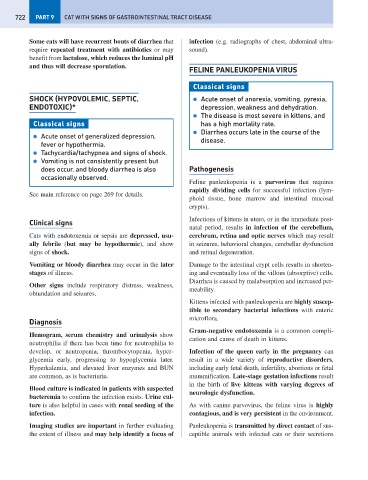Page 730 - Problem-Based Feline Medicine
P. 730
722 PART 9 CAT WITH SIGNS OF GASTROINTESTINAL TRACT DISEASE
Some cats will have recurrent bouts of diarrhea that infection (e.g. radiographs of chest, abdominal ultra-
require repeated treatment with antibiotics or may sound).
benefit from lactulose, which reduces the luminal pH
and thus will decrease sporulation.
FELINE PANLEUKOPENIA VIRUS
Classical signs
SHOCK (HYPOVOLEMIC, SEPTIC, ● Acute onset of anorexia, vomiting, pyrexia,
ENDOTOXIC)* depression, weakness and dehydration.
● The disease is most severe in kittens, and
Classical signs has a high mortality rate.
● Diarrhea occurs late in the course of the
● Acute onset of generalized depression,
disease.
fever or hypothermia.
● Tachycardia/tachypnea and signs of shock.
● Vomiting is not consistently present but
does occur, and bloody diarrhea is also Pathogenesis
occasionally observed.
Feline panleukopenia is a parvovirus that requires
rapidly dividing cells for successful infection (lym-
See main reference on page 269 for details.
phoid tissue, bone marrow and intestinal mucosal
crypts).
Infections of kittens in utero, or in the immediate post-
Clinical signs
natal period, results in infection of the cerebellum,
Cats with endotoxemia or sepsis are depressed, usu- cerebrum, retina and optic nerves which may result
ally febrile (but may be hypothermic), and show in seizures, behavioral changes, cerebellar dysfunction
signs of shock. and retinal degeneration.
Vomiting or bloody diarrhea may occur in the later Damage to the intestinal crypt cells results in shorten-
stages of illness. ing and eventually loss of the villous (absorptive) cells.
Diarrhea is caused by malabsorption and increased per-
Other signs include respiratory distress, weakness,
meability.
obtundation and seizures.
Kittens infected with panleukopenia are highly suscep-
tible to secondary bacterial infections with enteric
microflora.
Diagnosis
Gram-negative endotoxemia is a common compli-
Hemogram, serum chemistry and urinalysis show
cation and cause of death in kittens.
neutrophilia if there has been time for neutrophilia to
develop, or neutropenia, thrombocytopenia, hyper- Infection of the queen early in the pregnancy can
glycemia early, progressing to hypoglycemia later. result in a wide variety of reproductive disorders,
Hyperkalemia, and elevated liver enzymes and BUN including early fetal death, infertility, abortions or fetal
are common, as is bacteriuria. mummification. Late-stage gestation infections result
in the birth of live kittens with varying degrees of
Blood culture is indicated in patients with suspected
neurologic dysfunction.
bacteremia to confirm the infection exists. Urine cul-
ture is also helpful in cases with renal seeding of the As with canine parvovirus, the feline virus is highly
infection. contagious, and is very persistent in the environment.
Imaging studies are important in further evaluating Panleukopenia is transmitted by direct contact of sus-
the extent of illness and may help identify a focus of ceptible animals with infected cats or their secretions

